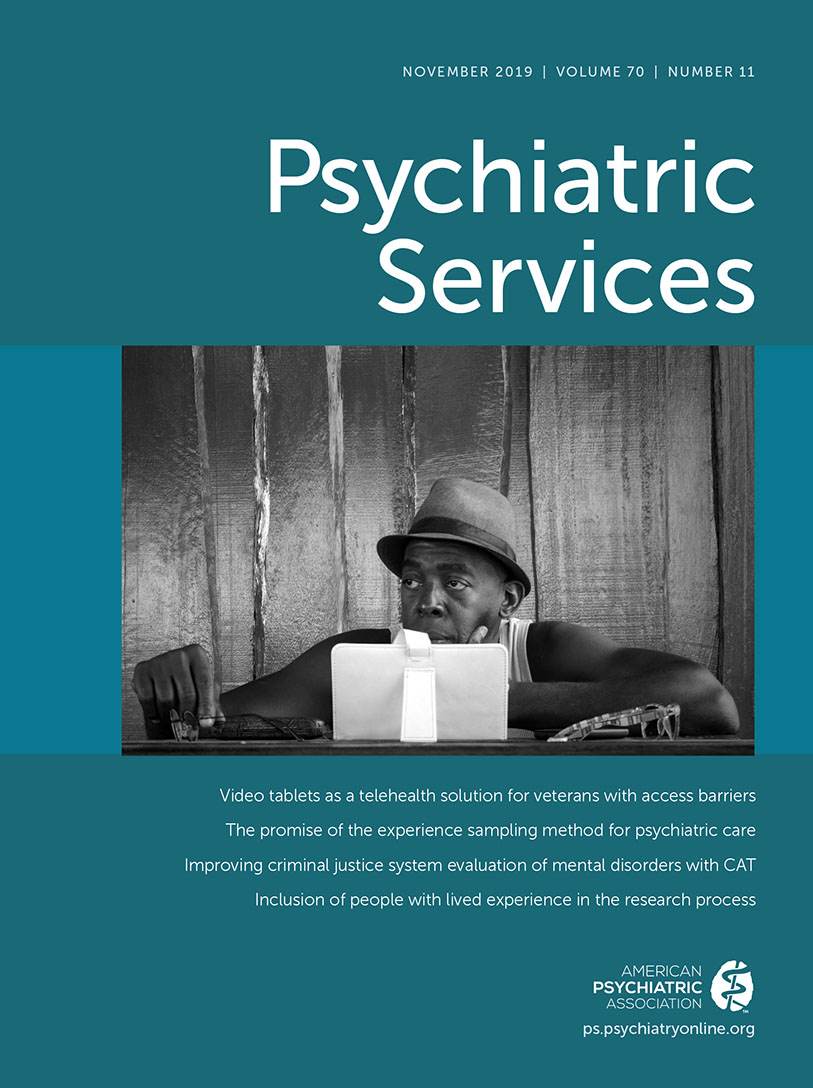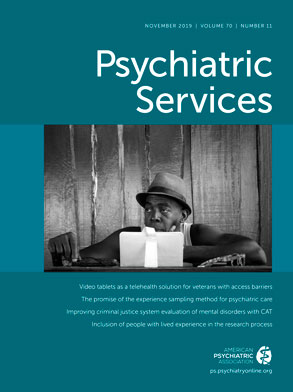Nonsuicidal self-injury (“self-injury”), purposefully damaging one’s body tissue (e.g., cutting, burning) without intent to die by suicide, is a serious and ubiquitous mental health concern (
1,
2). About 18% of adolescents (
1) and 13% of emerging adults report self-injury, as do about 8% of preadolescent youths (
2) and 5% of adults (ages ≥25) (
1). Unsurprisingly, self-injury is associated with an array of psychiatric difficulties (e.g., distress, anxiety) and mental illnesses (e.g., depression, eating disorders [
2]) and may lead to residual scarring, which can foment enduring shame (
3). Growing evidence points to the robust and unique role that self-injury plays in conferring suicide risk (
4). Furthermore, nonsuicidal self-injury has been recognized in the
DSM-5, thus underscoring its importance (
5).
Despite advances in public education, mental health literacy, and destigmatizing mental illness, efforts are lagging for self-injury. Many mental health difficulties (e.g., depression) are no longer viewed as constituting a failure of will or inability to “get over it.” Yet, self-injury is both self-inflicted and often physically visible. Hence, self-injury is arguably more difficult to understand, which can provoke negative attitudes, assumptions, and stereotypes. Indeed, self-injury stigma remains especially pronounced, even among health professionals, which contributes to people’s reluctance to seek services or disclose their experience (
6). This stigma may also hinder advances in research, given that people with lived experience of self-injury are rarely involved in the research process; this is in contrast to other areas with more established lived-experience initiatives (e.g., suicide, mood disorders). Consequently, there is a missed opportunity to incorporate their contribution to the development, conduct, and dissemination of research and to lend their voices to improving service provision. With this in mind, we present a call to action for greater inclusion of individuals with lived self-injury experience in all aspects of the research process.
Reasons to Include People With Lived Experience in Self-Injury Research
The World Health Organization has long advocated for empowerment of people with mental health difficulties and giving voice through engagement in research and health care. This involvement affords people with lived experience decision-making power and access to resources and treatment while fostering greater connectedness, self-esteem, and self-confidence. Initiatives have already been undertaken to include people with lived experience in research. For example, in Canada, the top funding agency for health research has allocated grant monies specific to patient-oriented research initiatives that directly involve people with lived experience as researchers (
http://www.cihr-irsc.gc.ca/e/51036.html). Yet, although the nature of consumer involvement is now integral to decisions about funding, inclusion of people with lived experience of self-injury in research rarely occurs.
This likely stems from the aforementioned stigma as well as researchers’ concerns about the impact of their involvement (which will be addressed later). Nonetheless, involvement of people with lived self-injury experience in research can have numerous benefits—to the project, the service provision, and the individuals themselves. Furthermore, evidence suggests that people who participate in self-injury research report altruistic and self-motivated reasons for doing so (
7). Taken together, there seems to be a clear willingness for individuals with lived self-injury experience to participate in research but efforts to meet these individuals’ desires are seemingly lacking.
Inclusion of people with lived experience facilitates priority-driven research, ensuring that research questions most relevant to individuals with a history of self-injury are posed. This could include research regarding barriers and facilitators to health care (
6), prevention, preferences concerning mode of service provision, diagnostic issues (
8), and training required for health professionals who provide treatment (
9). Additionally, broadening the definition of “individuals with lived experience” to include family, friends, school personnel, and mental health professionals (among others) will extend the impact of research and service provision, ensuring that the needs of all stakeholders are met and that findings are effectively disseminated to the most relevant stakeholders. Finally, inclusion of people with lived experience can enhance the integrity of research and services, encouraging use of person-centered language (e.g., avoiding terms like “cutter”;
10), framing questions in a sensitive and respectful manner, and minimizing triggering content. This has the advantage of educating all individuals about the need to be respectful when working with people who self-injure (
11).
Beyond the ways that inclusion of people with lived experience of self-injury can enhance the quality of research and service provision, such efforts afford significant benefits to individuals themselves. First, engagement in research may allow greater reflection on their own experiences, providing greater insight into their own self-injury. Indeed, there is growing evidence that involvement in self-injury research, and related areas (e.g., suicide), does not produce adverse effects, but rather offers benefits, including increased self-awareness and help seeking (
12). Second, involving people with lived experience gives a voice to those who are unwilling or unable to share their own story because of stigma. As with mental illness generally, disclosing self-injury may reduce self-stigma, yield opportunities for supportive relationships (
13), and foster the use of services. Finally, the empowerment afforded by actively engaging in research can increase self-esteem, self-confidence, and provide a sense of meaning for people who self-injure (
14). This may be particularly true for people with lived experience who are in a position to lead projects.
Not only is there a need for efforts to involve people with lived self-injury experience in research, but there also is an opportunity for the field of self-injury research to lead in this regard. Indeed, individuals with lived self-injury experience who become researchers have the opportunity to guide research agendas, mentor junior researchers (who may have their own experiences of self-injury), and potentially inspire others to take on leadership roles. Such efforts are conducive to challenging the stigma associated with self-injury while demonstrating how lived experience can play an integral role in advancing the field.
Strategies to Include People With Lived Experience in Self-Injury Research
Beyond their obvious and historical involvement as participants, individuals with lived self-injury experience can serve multiple roles, in different phases and across various forms of research. In what follows, we offer general recommendations that can be implemented to foster such involvement. The online supplemental table has more specific strategies and considerations.
Initial recruitment.
As a first step, it may be useful to consult with and refer to existing organizations involving individuals with lived experience. For example, people with lived experience are acknowledged by a dedicated membership division within the American Association of Suicidology and its annual conference. Establishing similar initiatives for organizations focused on self-injury (e.g., the International Society for the Study of Self-Injury) may thus have merit. Doing so may also offer a means to recruit individuals in the research process. Additionally, with increased efforts to engage people with lived self-injury experience via online outreach (e.g.,
www.sioutreach.org), the Internet may represent another means to involve people in research.
Research involvement.
Efforts can be made to include people with lived self-injury experience in early discussions to ascertain research foci. As experts in the experience of self-injury, these individuals are well positioned to offer unique insights that may otherwise go overlooked. Their views on treatment provision (e.g., ways to optimally deliver services) may have particular salience given the current lack of evidence in this domain. Likewise, their views on tackling stigma may be germane when enhancing treatment delivery. Commensurate with this, as noted earlier, the World Health Organization has indicated that immersion of people with lived experience in research on mental health service provision is especially beneficial. Congruently, individuals with lived experience can be invited to offer perspectives through meetings with research teams. Such discussions can address ways to tackle particular questions and highlight how participants may experience the research itself. This is conducive to yielding unique viewpoints, affording people with lived experience a needed voice, and elucidating ways to mitigate potential risks.
Inasmuch as people with lived experience can contribute to discussions early in the research process, the same can transpire in the context of dissemination. These individuals may have unique suggestions about how to maximize the reach and effect of research findings (e.g., effectively targeting relevant stakeholders). Furthermore, at academic and professional meetings, individuals can be invited as panel members to share their experiences (e.g., regarding particular foci/themes) with targeted stakeholders (e.g., service providers) and to discuss potential research avenues.
Ethical considerations.
Notwithstanding the approaches described above, it is essential that initiatives to involve people with lived experience in self-injury research be prudently undertaken. Indeed, self-injury as a field is unique in terms of the nature of potential risks associated with research participation (
15). Depending on the nature of a given project, some aspects of the research process may be inadvertently distressing or triggering (e.g., studies using mood induction or self-injury imagery). Accordingly, in these instances, we suggest drawing on recommendations for conducting ethical self-injury research to mitigate adverse outcomes (
15). For example, ongoing communication about the nature of potential reactions to the research process is advised. Provision of resources is also recommended (see the table in the online
online supplement to this Open Forum). Here, individuals should be offered self-injury–specific resources (e.g., coping strategies) alongside those relevant to obtaining professional support and services in one’s community.
Conclusions
The value of including people with lived self-injury experience in research is self-evident—especially given its potential to augment service provision. Given significant benefits, both to the merit of the research and the individuals involved, we call on all researchers to actively involve people with lived self-injury experience whenever possible. In designing research projects, researchers should consider how best to collaborate with people with lived experience and where their expertise best fits in the research context. Further, people with lived experience might consider how they can contribute to the research process, through shaping the research agenda, lending their voice in an advisory capacity, or in disseminating research findings to key stakeholders.

